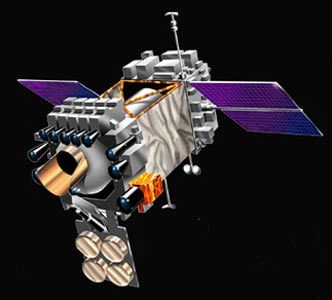
Home - Search - Browse - Alphabetic Index: 0- 1- 2- 3- 4- 5- 6- 7- 8- 9
A- B- C- D- E- F- G- H- I- J- K- L- M- N- O- P- Q- R- S- T- U- V- W- X- Y- Z
MSX
 MSX Credit: Manufacturer Image |
AKA: Midcourse Space Experiment. Status: Operational 1996. First Launch: 1996-04-24. Last Launch: 1996-04-24. Number: 1 . Gross mass: 2,700 kg (5,900 lb). Height: 5.10 m (16.70 ft).
The MSX Midcourse Space eXperiment observatory was a BMDO sponsored mission designed to demonstrate a variety of multispectral imaging technologies to identify and track ballistic missiles during flight. In addition, it performed scientific investigations of the composition and dynamics of the Earth's atmosphere by observing ozone, chlorofluorocarbons, carbon dioxide and methane.
The spacecraft was 3-axis stabilized to 0.01 deg using reaction wheels with knowledge to 9 µ rad (post-processed). 108 Gbits data storage were available. Communications were via steerable X-band antennas with 2 kbps uplink and downlink up to 25 Mbps. Dual solar arrays (single-axis articulation) provided 1200 W BOL and recharged NiH2 batteries. The instruments consisted of 11 optical sensors making observations at a wide range of infrared, visible and ultraviolet wavelengths from 110 nm to 28 µ m. Primary instruments were the SPIRIT III (Space Infrared Imaging Telescope), UVISI (Ultraviolet and Visible Imagers and Spectrographic Imagers), SBV (Space-Based Visible instrument), and OSDP (On-board Signal and Data Processor). Reference objects (2 cm spheres) were to be deployed from MSX for observation by the sensors.
The initial project started 1988 with an estimated cost of $ 800 million. This was reduced to $ 350 million. Spacecraft cost was estimated at $325M. Utah State University built SPIRIT III, Hughes the OSDP.
NASA NSSDC Master Catalog Description
The Midcourse Space Experiment (MSX) was a test project of the Ballistic Missile Defense Organization (BMDO). Its primary purpose was to gather data over a wide-wavelength interval to demonstrate the feasibility of identifying and tracking ballistic missiles during their midcourse flight phase. Its multispectral instruments were capable of obtaining wide band and spectral images in the range of ultraviolet to infrared wavelengths (110 nm to 28,000 nm). The instruments were also utilized for civilian aeronomic and auroral studies.
The 5.1 m spacecraft consisted of three sections each of 1.5 m x 1.5 m cross-section to house three payload components: an electronics section, an 8.5 K frozen hydrogen section, and an instruments section. The three instruments were: SPIRIT III (Space Infrared Imaging Telescope), a five-color, high-spatial resolution scanning radiometer and a six-channel, high-spectral resolution, Fourier-transform spectrometer; UVISI (Ultraviolet and Visible Imagers and Spectrographic Imagers), five spectrographic imagers and four UV/visible imagers with capabilities from the far ultraviolet through visible wavelengths; and, Space-Based Visible (SBV), a visible band telescope with a six-inch aperturn, a charge-coupled device, and image processing electronics. Also on-board were the On-board Signal and Data Processor (OSDP), which provided real-time signal processing for target detection and tracking for data generated by SPIRIT III, sensors for monitoring and measuring instrument contamination and degradation of performance largely due to outgassing, and a number of small (2.0 cm) reference spheres, deployed as reference objects from MSX for instrument calibration.
More at: MSX.
Family: Military, Military strategic defense sat, Sun synchronous orbit. Country: USA. Launch Vehicles: Thor, Delta, Delta 2 7000, Delta 7920-10. Launch Sites: Vandenberg, Vandenberg SLC2W. Agency: APL, BMDO. Bibliography: 2, 4, 6, 11481, 12862.
1996 April 24 - . 12:27 GMT - . Launch Site: Vandenberg. Launch Complex: Vandenberg SLC2W. LV Family: Thor. Launch Vehicle: Delta 7920-10.
- MSX - . Mass: 2,700 kg (5,900 lb). Nation: USA. Agency: BMDO. Class: Military. Type: Strategic defense satellite. Spacecraft: MSX. USAF Sat Cat: 23851 . COSPAR: 1996-024A. Apogee: 907 km (563 mi). Perigee: 897 km (557 mi). Inclination: 99.40 deg. Period: 103.10 min. LEO. Midcourse Space eXperiment; missile detection technology tests; also used for auroral and atmospheric studies .
Back to top of page
Home - Search - Browse - Alphabetic Index: 0- 1- 2- 3- 4- 5- 6- 7- 8- 9
A- B- C- D- E- F- G- H- I- J- K- L- M- N- O- P- Q- R- S- T- U- V- W- X- Y- Z
© 1997-2019 Mark Wade - Contact
© / Conditions for Use